Managing Food Production Systems: A Report for Chelsea Dining
VerifiedAdded on 2023/01/06
|9
|2629
|41
Report
AI Summary
This report provides a detailed analysis of various food production and preparation systems suitable for Chelsea Dining Room, focusing on its a la carte menu. It begins by defining and comparing different food production systems, including conventional, assembly/serve, and commissary systems, highlighting their advantages and disadvantages. The report then explores different food preparation systems, such as cook-chill, sous vide, and cook-freeze methods. Furthermore, the report examines the factors influencing the design of food preparation and production systems, including cooking ranges, storage and display, ventilation requirements, and pest control. The analysis aims to provide Chelsea Dining Room with insights into optimizing its food production processes to meet customer needs and business objectives. The report also discusses the advantages and disadvantages of each system, providing a comprehensive understanding of the topic.
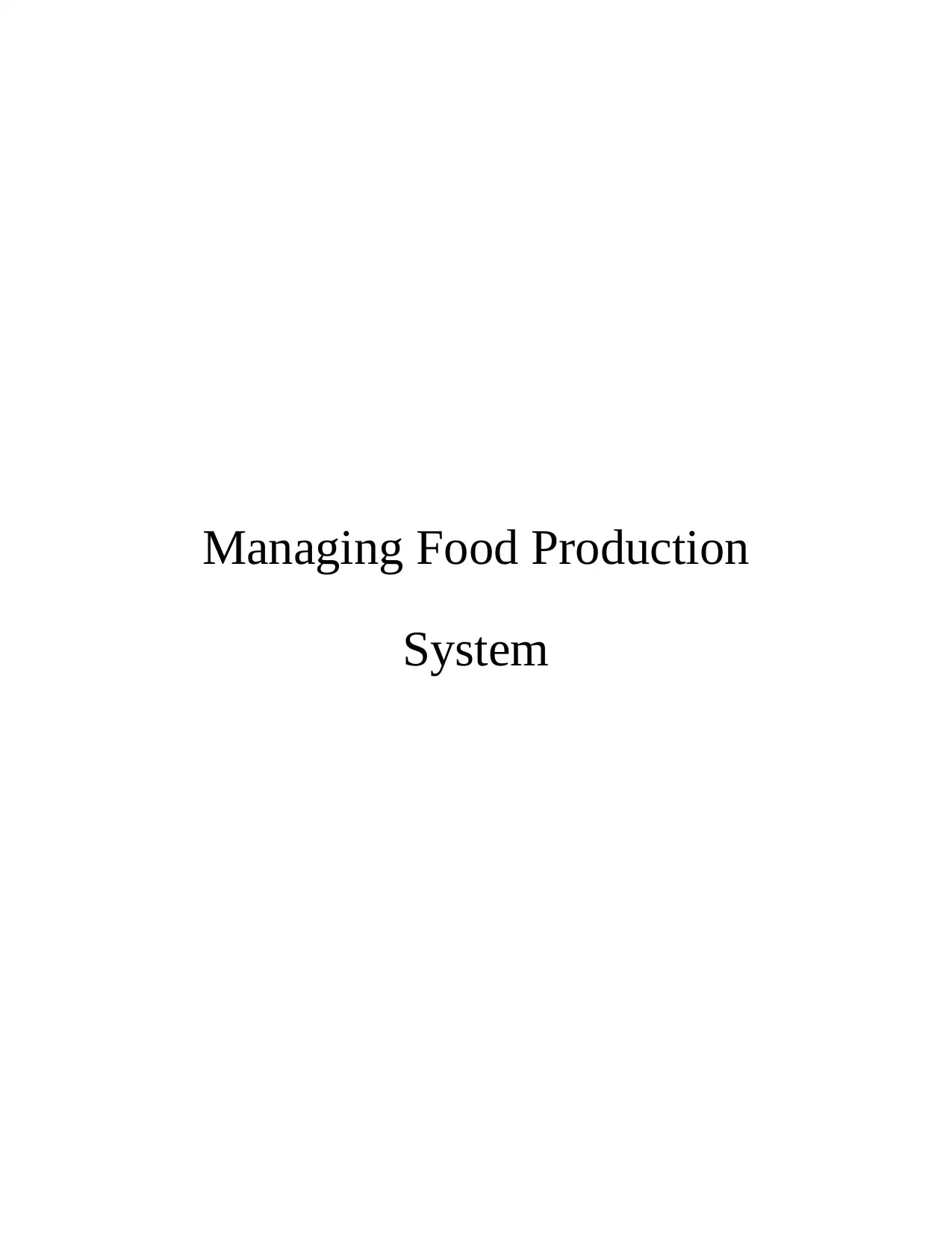
Managing Food Production
System
System
Paraphrase This Document
Need a fresh take? Get an instant paraphrase of this document with our AI Paraphraser
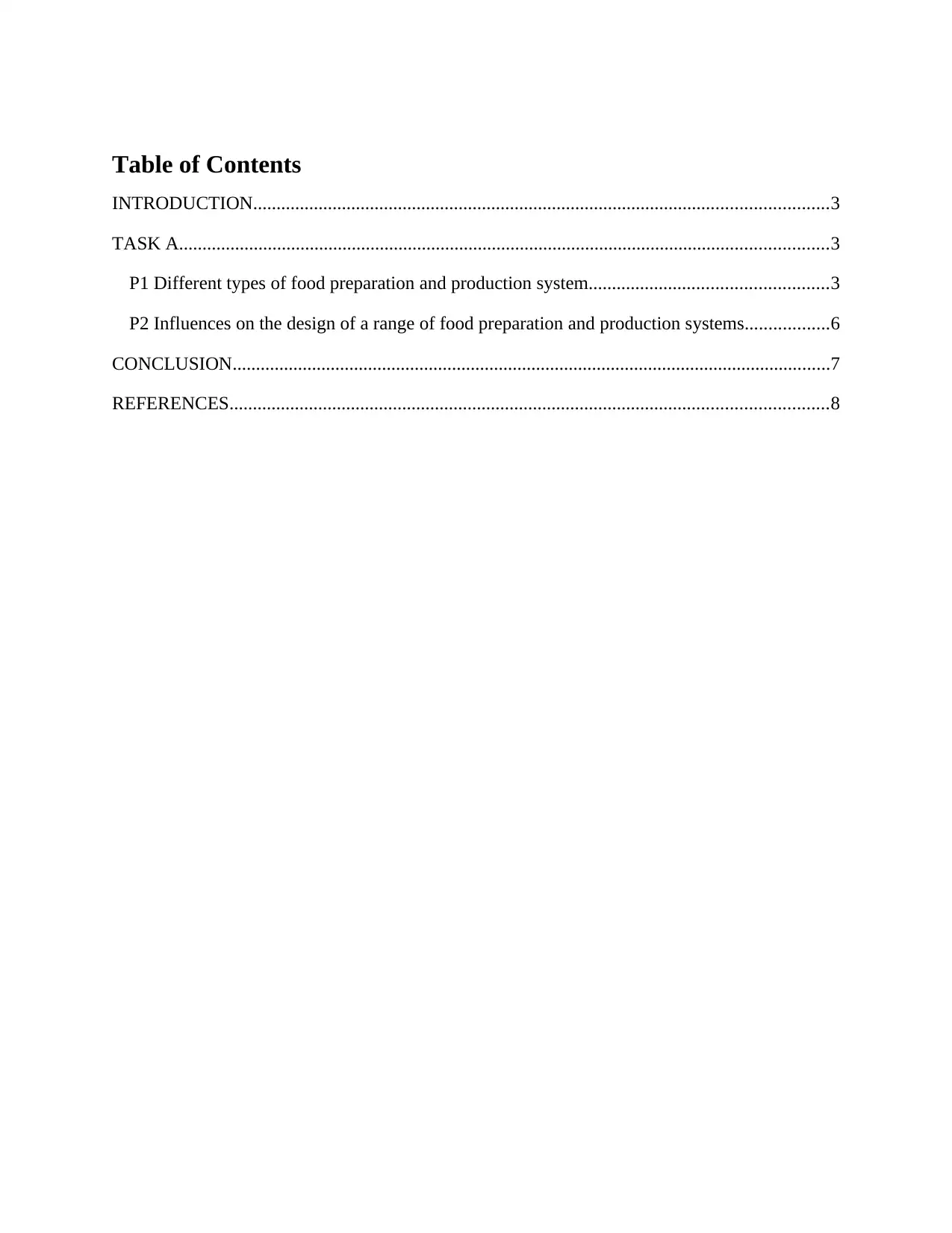
Table of Contents
INTRODUCTION...........................................................................................................................3
TASK A...........................................................................................................................................3
P1 Different types of food preparation and production system...................................................3
P2 Influences on the design of a range of food preparation and production systems..................6
CONCLUSION................................................................................................................................7
REFERENCES................................................................................................................................8
INTRODUCTION...........................................................................................................................3
TASK A...........................................................................................................................................3
P1 Different types of food preparation and production system...................................................3
P2 Influences on the design of a range of food preparation and production systems..................6
CONCLUSION................................................................................................................................7
REFERENCES................................................................................................................................8
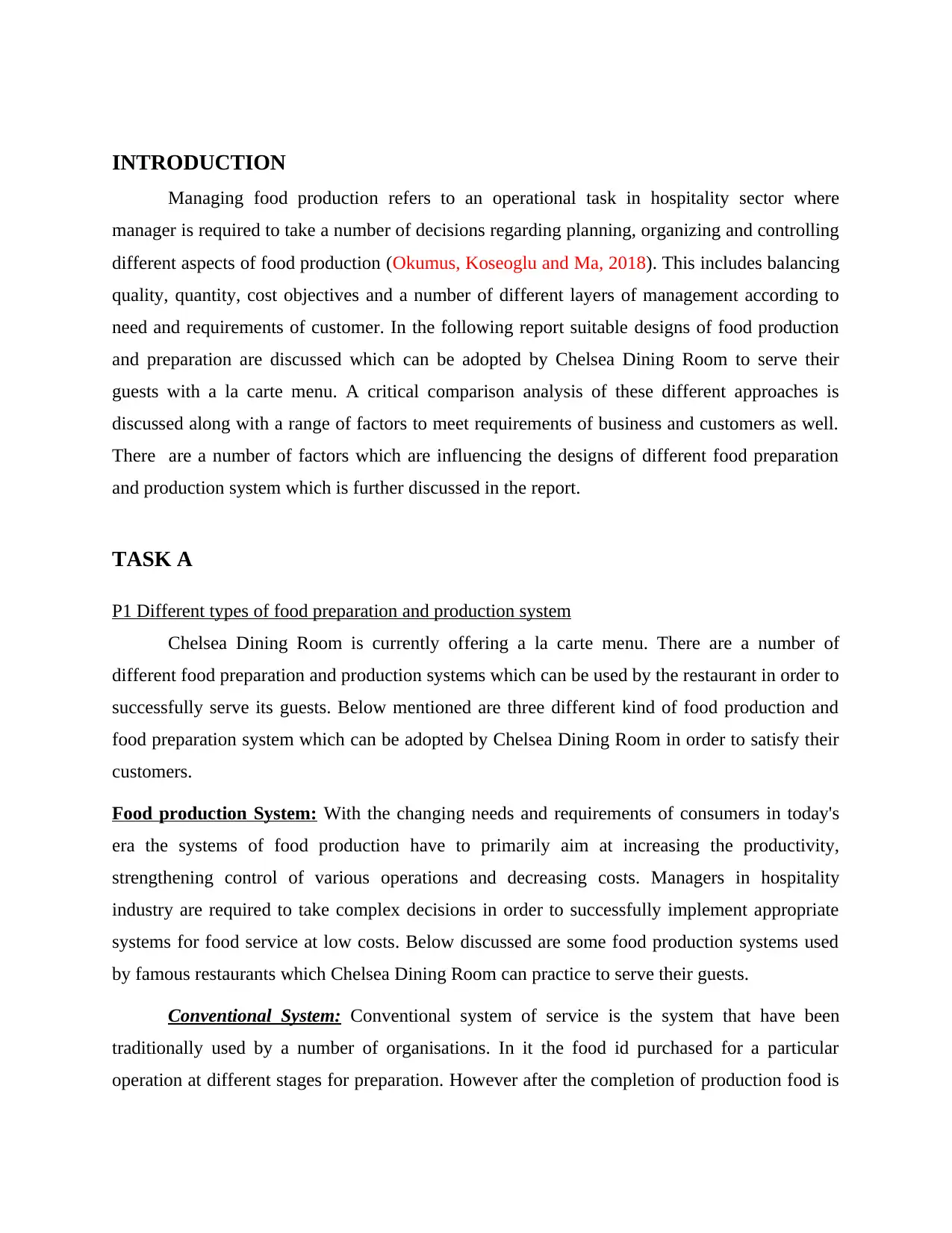
INTRODUCTION
Managing food production refers to an operational task in hospitality sector where
manager is required to take a number of decisions regarding planning, organizing and controlling
different aspects of food production (Okumus, Koseoglu and Ma, 2018). This includes balancing
quality, quantity, cost objectives and a number of different layers of management according to
need and requirements of customer. In the following report suitable designs of food production
and preparation are discussed which can be adopted by Chelsea Dining Room to serve their
guests with a la carte menu. A critical comparison analysis of these different approaches is
discussed along with a range of factors to meet requirements of business and customers as well.
There are a number of factors which are influencing the designs of different food preparation
and production system which is further discussed in the report.
TASK A
P1 Different types of food preparation and production system
Chelsea Dining Room is currently offering a la carte menu. There are a number of
different food preparation and production systems which can be used by the restaurant in order to
successfully serve its guests. Below mentioned are three different kind of food production and
food preparation system which can be adopted by Chelsea Dining Room in order to satisfy their
customers.
Food production System: With the changing needs and requirements of consumers in today's
era the systems of food production have to primarily aim at increasing the productivity,
strengthening control of various operations and decreasing costs. Managers in hospitality
industry are required to take complex decisions in order to successfully implement appropriate
systems for food service at low costs. Below discussed are some food production systems used
by famous restaurants which Chelsea Dining Room can practice to serve their guests.
Conventional System: Conventional system of service is the system that have been
traditionally used by a number of organisations. In it the food id purchased for a particular
operation at different stages for preparation. However after the completion of production food is
Managing food production refers to an operational task in hospitality sector where
manager is required to take a number of decisions regarding planning, organizing and controlling
different aspects of food production (Okumus, Koseoglu and Ma, 2018). This includes balancing
quality, quantity, cost objectives and a number of different layers of management according to
need and requirements of customer. In the following report suitable designs of food production
and preparation are discussed which can be adopted by Chelsea Dining Room to serve their
guests with a la carte menu. A critical comparison analysis of these different approaches is
discussed along with a range of factors to meet requirements of business and customers as well.
There are a number of factors which are influencing the designs of different food preparation
and production system which is further discussed in the report.
TASK A
P1 Different types of food preparation and production system
Chelsea Dining Room is currently offering a la carte menu. There are a number of
different food preparation and production systems which can be used by the restaurant in order to
successfully serve its guests. Below mentioned are three different kind of food production and
food preparation system which can be adopted by Chelsea Dining Room in order to satisfy their
customers.
Food production System: With the changing needs and requirements of consumers in today's
era the systems of food production have to primarily aim at increasing the productivity,
strengthening control of various operations and decreasing costs. Managers in hospitality
industry are required to take complex decisions in order to successfully implement appropriate
systems for food service at low costs. Below discussed are some food production systems used
by famous restaurants which Chelsea Dining Room can practice to serve their guests.
Conventional System: Conventional system of service is the system that have been
traditionally used by a number of organisations. In it the food id purchased for a particular
operation at different stages for preparation. However after the completion of production food is
⊘ This is a preview!⊘
Do you want full access?
Subscribe today to unlock all pages.

Trusted by 1+ million students worldwide
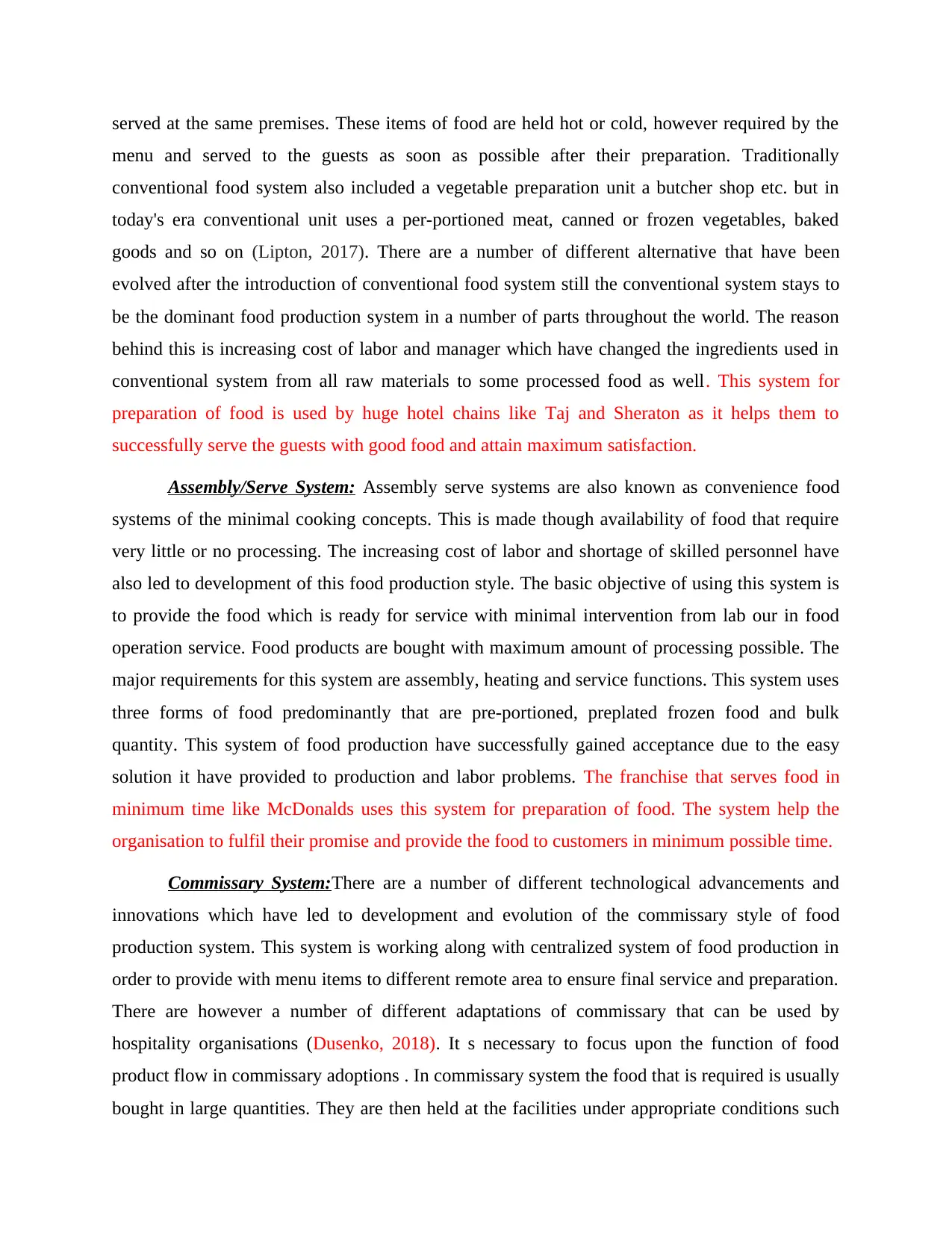
served at the same premises. These items of food are held hot or cold, however required by the
menu and served to the guests as soon as possible after their preparation. Traditionally
conventional food system also included a vegetable preparation unit a butcher shop etc. but in
today's era conventional unit uses a per-portioned meat, canned or frozen vegetables, baked
goods and so on (Lipton, 2017). There are a number of different alternative that have been
evolved after the introduction of conventional food system still the conventional system stays to
be the dominant food production system in a number of parts throughout the world. The reason
behind this is increasing cost of labor and manager which have changed the ingredients used in
conventional system from all raw materials to some processed food as well. This system for
preparation of food is used by huge hotel chains like Taj and Sheraton as it helps them to
successfully serve the guests with good food and attain maximum satisfaction.
Assembly/Serve System: Assembly serve systems are also known as convenience food
systems of the minimal cooking concepts. This is made though availability of food that require
very little or no processing. The increasing cost of labor and shortage of skilled personnel have
also led to development of this food production style. The basic objective of using this system is
to provide the food which is ready for service with minimal intervention from lab our in food
operation service. Food products are bought with maximum amount of processing possible. The
major requirements for this system are assembly, heating and service functions. This system uses
three forms of food predominantly that are pre-portioned, preplated frozen food and bulk
quantity. This system of food production have successfully gained acceptance due to the easy
solution it have provided to production and labor problems. The franchise that serves food in
minimum time like McDonalds uses this system for preparation of food. The system help the
organisation to fulfil their promise and provide the food to customers in minimum possible time.
Commissary System:There are a number of different technological advancements and
innovations which have led to development and evolution of the commissary style of food
production system. This system is working along with centralized system of food production in
order to provide with menu items to different remote area to ensure final service and preparation.
There are however a number of different adaptations of commissary that can be used by
hospitality organisations (Dusenko, 2018). It s necessary to focus upon the function of food
product flow in commissary adoptions . In commissary system the food that is required is usually
bought in large quantities. They are then held at the facilities under appropriate conditions such
menu and served to the guests as soon as possible after their preparation. Traditionally
conventional food system also included a vegetable preparation unit a butcher shop etc. but in
today's era conventional unit uses a per-portioned meat, canned or frozen vegetables, baked
goods and so on (Lipton, 2017). There are a number of different alternative that have been
evolved after the introduction of conventional food system still the conventional system stays to
be the dominant food production system in a number of parts throughout the world. The reason
behind this is increasing cost of labor and manager which have changed the ingredients used in
conventional system from all raw materials to some processed food as well. This system for
preparation of food is used by huge hotel chains like Taj and Sheraton as it helps them to
successfully serve the guests with good food and attain maximum satisfaction.
Assembly/Serve System: Assembly serve systems are also known as convenience food
systems of the minimal cooking concepts. This is made though availability of food that require
very little or no processing. The increasing cost of labor and shortage of skilled personnel have
also led to development of this food production style. The basic objective of using this system is
to provide the food which is ready for service with minimal intervention from lab our in food
operation service. Food products are bought with maximum amount of processing possible. The
major requirements for this system are assembly, heating and service functions. This system uses
three forms of food predominantly that are pre-portioned, preplated frozen food and bulk
quantity. This system of food production have successfully gained acceptance due to the easy
solution it have provided to production and labor problems. The franchise that serves food in
minimum time like McDonalds uses this system for preparation of food. The system help the
organisation to fulfil their promise and provide the food to customers in minimum possible time.
Commissary System:There are a number of different technological advancements and
innovations which have led to development and evolution of the commissary style of food
production system. This system is working along with centralized system of food production in
order to provide with menu items to different remote area to ensure final service and preparation.
There are however a number of different adaptations of commissary that can be used by
hospitality organisations (Dusenko, 2018). It s necessary to focus upon the function of food
product flow in commissary adoptions . In commissary system the food that is required is usually
bought in large quantities. They are then held at the facilities under appropriate conditions such
Paraphrase This Document
Need a fresh take? Get an instant paraphrase of this document with our AI Paraphraser
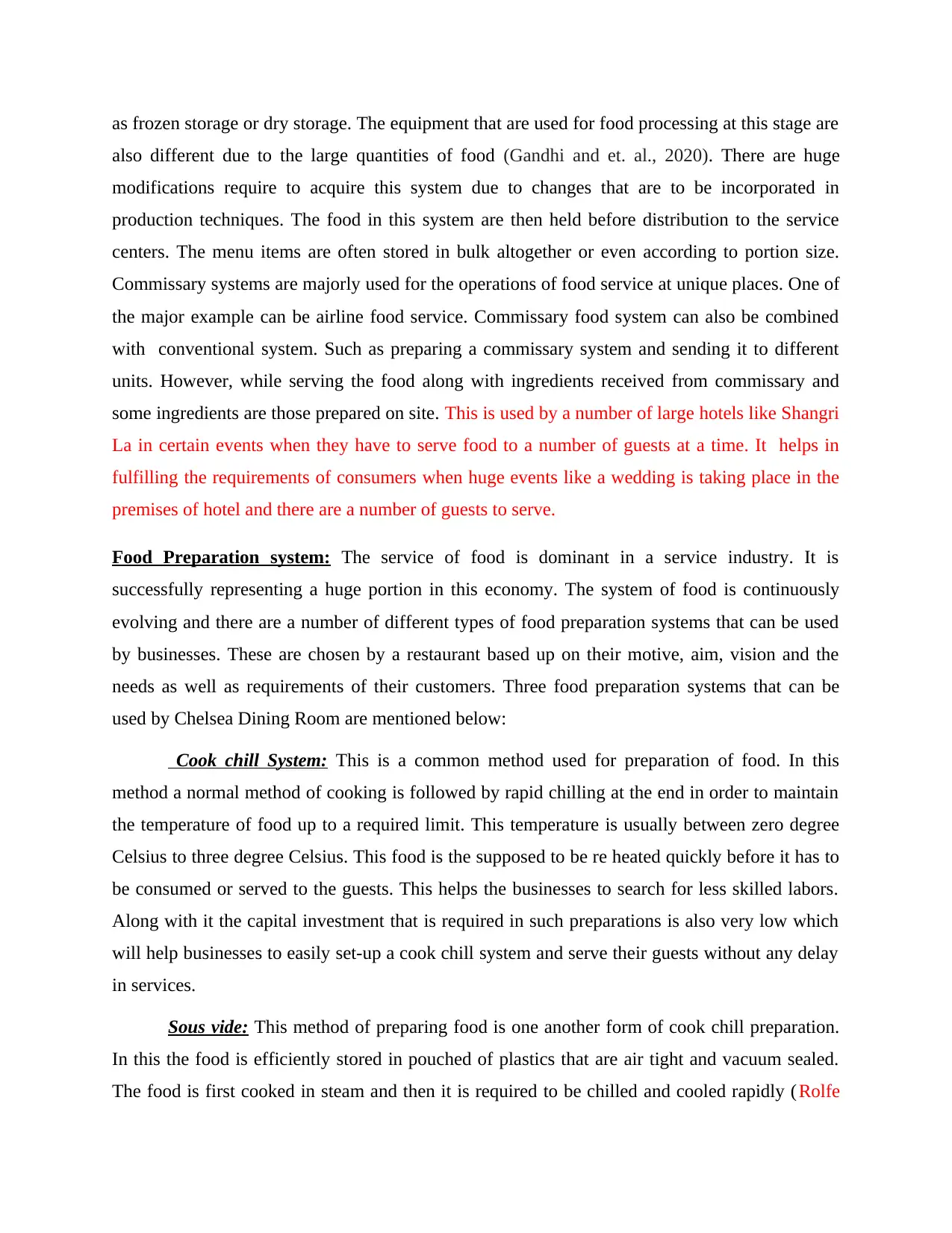
as frozen storage or dry storage. The equipment that are used for food processing at this stage are
also different due to the large quantities of food (Gandhi and et. al., 2020). There are huge
modifications require to acquire this system due to changes that are to be incorporated in
production techniques. The food in this system are then held before distribution to the service
centers. The menu items are often stored in bulk altogether or even according to portion size.
Commissary systems are majorly used for the operations of food service at unique places. One of
the major example can be airline food service. Commissary food system can also be combined
with conventional system. Such as preparing a commissary system and sending it to different
units. However, while serving the food along with ingredients received from commissary and
some ingredients are those prepared on site. This is used by a number of large hotels like Shangri
La in certain events when they have to serve food to a number of guests at a time. It helps in
fulfilling the requirements of consumers when huge events like a wedding is taking place in the
premises of hotel and there are a number of guests to serve.
Food Preparation system: The service of food is dominant in a service industry. It is
successfully representing a huge portion in this economy. The system of food is continuously
evolving and there are a number of different types of food preparation systems that can be used
by businesses. These are chosen by a restaurant based up on their motive, aim, vision and the
needs as well as requirements of their customers. Three food preparation systems that can be
used by Chelsea Dining Room are mentioned below:
Cook chill System: This is a common method used for preparation of food. In this
method a normal method of cooking is followed by rapid chilling at the end in order to maintain
the temperature of food up to a required limit. This temperature is usually between zero degree
Celsius to three degree Celsius. This food is the supposed to be re heated quickly before it has to
be consumed or served to the guests. This helps the businesses to search for less skilled labors.
Along with it the capital investment that is required in such preparations is also very low which
will help businesses to easily set-up a cook chill system and serve their guests without any delay
in services.
Sous vide: This method of preparing food is one another form of cook chill preparation.
In this the food is efficiently stored in pouched of plastics that are air tight and vacuum sealed.
The food is first cooked in steam and then it is required to be chilled and cooled rapidly (Rolfe
also different due to the large quantities of food (Gandhi and et. al., 2020). There are huge
modifications require to acquire this system due to changes that are to be incorporated in
production techniques. The food in this system are then held before distribution to the service
centers. The menu items are often stored in bulk altogether or even according to portion size.
Commissary systems are majorly used for the operations of food service at unique places. One of
the major example can be airline food service. Commissary food system can also be combined
with conventional system. Such as preparing a commissary system and sending it to different
units. However, while serving the food along with ingredients received from commissary and
some ingredients are those prepared on site. This is used by a number of large hotels like Shangri
La in certain events when they have to serve food to a number of guests at a time. It helps in
fulfilling the requirements of consumers when huge events like a wedding is taking place in the
premises of hotel and there are a number of guests to serve.
Food Preparation system: The service of food is dominant in a service industry. It is
successfully representing a huge portion in this economy. The system of food is continuously
evolving and there are a number of different types of food preparation systems that can be used
by businesses. These are chosen by a restaurant based up on their motive, aim, vision and the
needs as well as requirements of their customers. Three food preparation systems that can be
used by Chelsea Dining Room are mentioned below:
Cook chill System: This is a common method used for preparation of food. In this
method a normal method of cooking is followed by rapid chilling at the end in order to maintain
the temperature of food up to a required limit. This temperature is usually between zero degree
Celsius to three degree Celsius. This food is the supposed to be re heated quickly before it has to
be consumed or served to the guests. This helps the businesses to search for less skilled labors.
Along with it the capital investment that is required in such preparations is also very low which
will help businesses to easily set-up a cook chill system and serve their guests without any delay
in services.
Sous vide: This method of preparing food is one another form of cook chill preparation.
In this the food is efficiently stored in pouched of plastics that are air tight and vacuum sealed.
The food is first cooked in steam and then it is required to be chilled and cooled rapidly (Rolfe
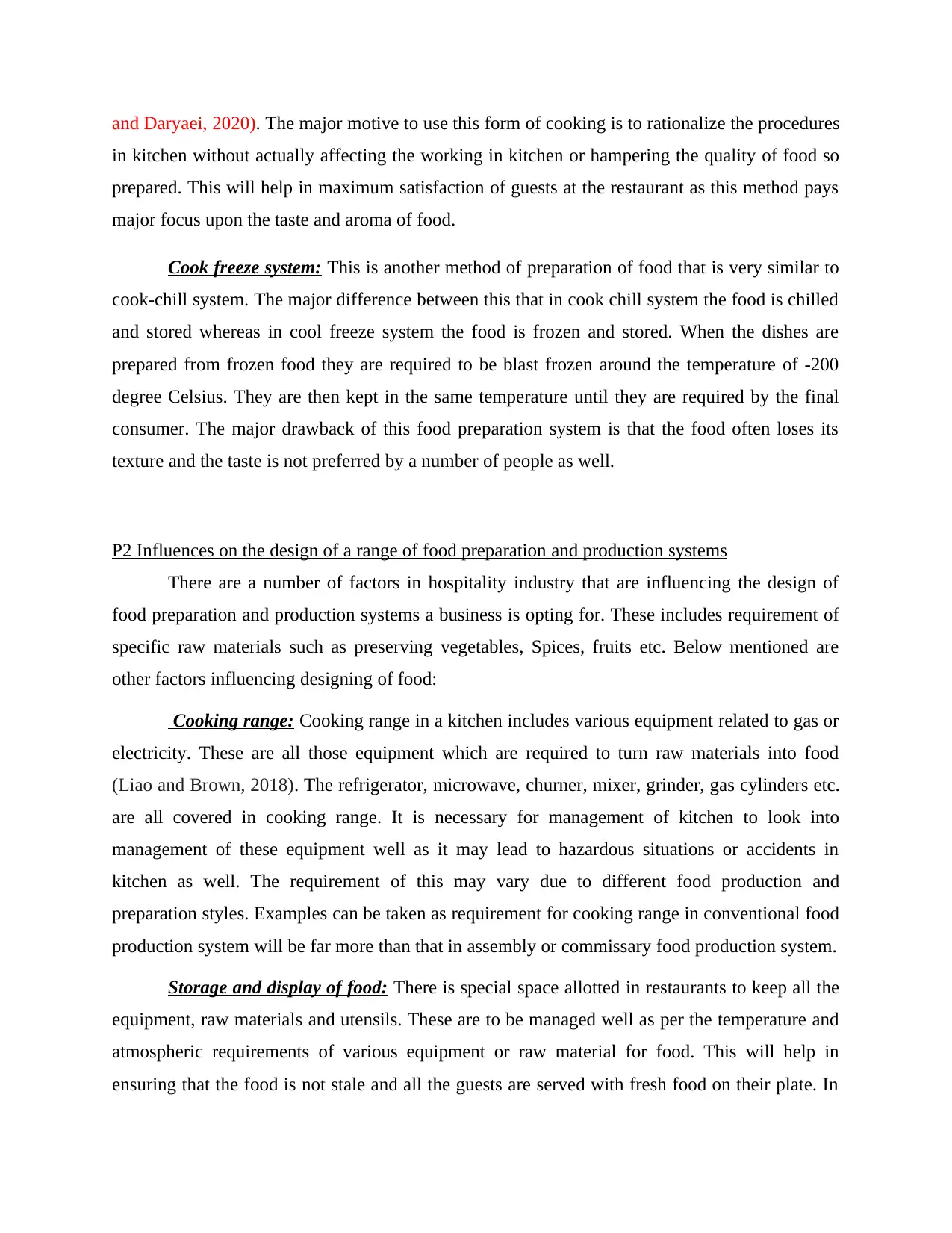
and Daryaei, 2020). The major motive to use this form of cooking is to rationalize the procedures
in kitchen without actually affecting the working in kitchen or hampering the quality of food so
prepared. This will help in maximum satisfaction of guests at the restaurant as this method pays
major focus upon the taste and aroma of food.
Cook freeze system: This is another method of preparation of food that is very similar to
cook-chill system. The major difference between this that in cook chill system the food is chilled
and stored whereas in cool freeze system the food is frozen and stored. When the dishes are
prepared from frozen food they are required to be blast frozen around the temperature of -200
degree Celsius. They are then kept in the same temperature until they are required by the final
consumer. The major drawback of this food preparation system is that the food often loses its
texture and the taste is not preferred by a number of people as well.
P2 Influences on the design of a range of food preparation and production systems
There are a number of factors in hospitality industry that are influencing the design of
food preparation and production systems a business is opting for. These includes requirement of
specific raw materials such as preserving vegetables, Spices, fruits etc. Below mentioned are
other factors influencing designing of food:
Cooking range: Cooking range in a kitchen includes various equipment related to gas or
electricity. These are all those equipment which are required to turn raw materials into food
(Liao and Brown, 2018). The refrigerator, microwave, churner, mixer, grinder, gas cylinders etc.
are all covered in cooking range. It is necessary for management of kitchen to look into
management of these equipment well as it may lead to hazardous situations or accidents in
kitchen as well. The requirement of this may vary due to different food production and
preparation styles. Examples can be taken as requirement for cooking range in conventional food
production system will be far more than that in assembly or commissary food production system.
Storage and display of food: There is special space allotted in restaurants to keep all the
equipment, raw materials and utensils. These are to be managed well as per the temperature and
atmospheric requirements of various equipment or raw material for food. This will help in
ensuring that the food is not stale and all the guests are served with fresh food on their plate. In
in kitchen without actually affecting the working in kitchen or hampering the quality of food so
prepared. This will help in maximum satisfaction of guests at the restaurant as this method pays
major focus upon the taste and aroma of food.
Cook freeze system: This is another method of preparation of food that is very similar to
cook-chill system. The major difference between this that in cook chill system the food is chilled
and stored whereas in cool freeze system the food is frozen and stored. When the dishes are
prepared from frozen food they are required to be blast frozen around the temperature of -200
degree Celsius. They are then kept in the same temperature until they are required by the final
consumer. The major drawback of this food preparation system is that the food often loses its
texture and the taste is not preferred by a number of people as well.
P2 Influences on the design of a range of food preparation and production systems
There are a number of factors in hospitality industry that are influencing the design of
food preparation and production systems a business is opting for. These includes requirement of
specific raw materials such as preserving vegetables, Spices, fruits etc. Below mentioned are
other factors influencing designing of food:
Cooking range: Cooking range in a kitchen includes various equipment related to gas or
electricity. These are all those equipment which are required to turn raw materials into food
(Liao and Brown, 2018). The refrigerator, microwave, churner, mixer, grinder, gas cylinders etc.
are all covered in cooking range. It is necessary for management of kitchen to look into
management of these equipment well as it may lead to hazardous situations or accidents in
kitchen as well. The requirement of this may vary due to different food production and
preparation styles. Examples can be taken as requirement for cooking range in conventional food
production system will be far more than that in assembly or commissary food production system.
Storage and display of food: There is special space allotted in restaurants to keep all the
equipment, raw materials and utensils. These are to be managed well as per the temperature and
atmospheric requirements of various equipment or raw material for food. This will help in
ensuring that the food is not stale and all the guests are served with fresh food on their plate. In
⊘ This is a preview!⊘
Do you want full access?
Subscribe today to unlock all pages.

Trusted by 1+ million students worldwide
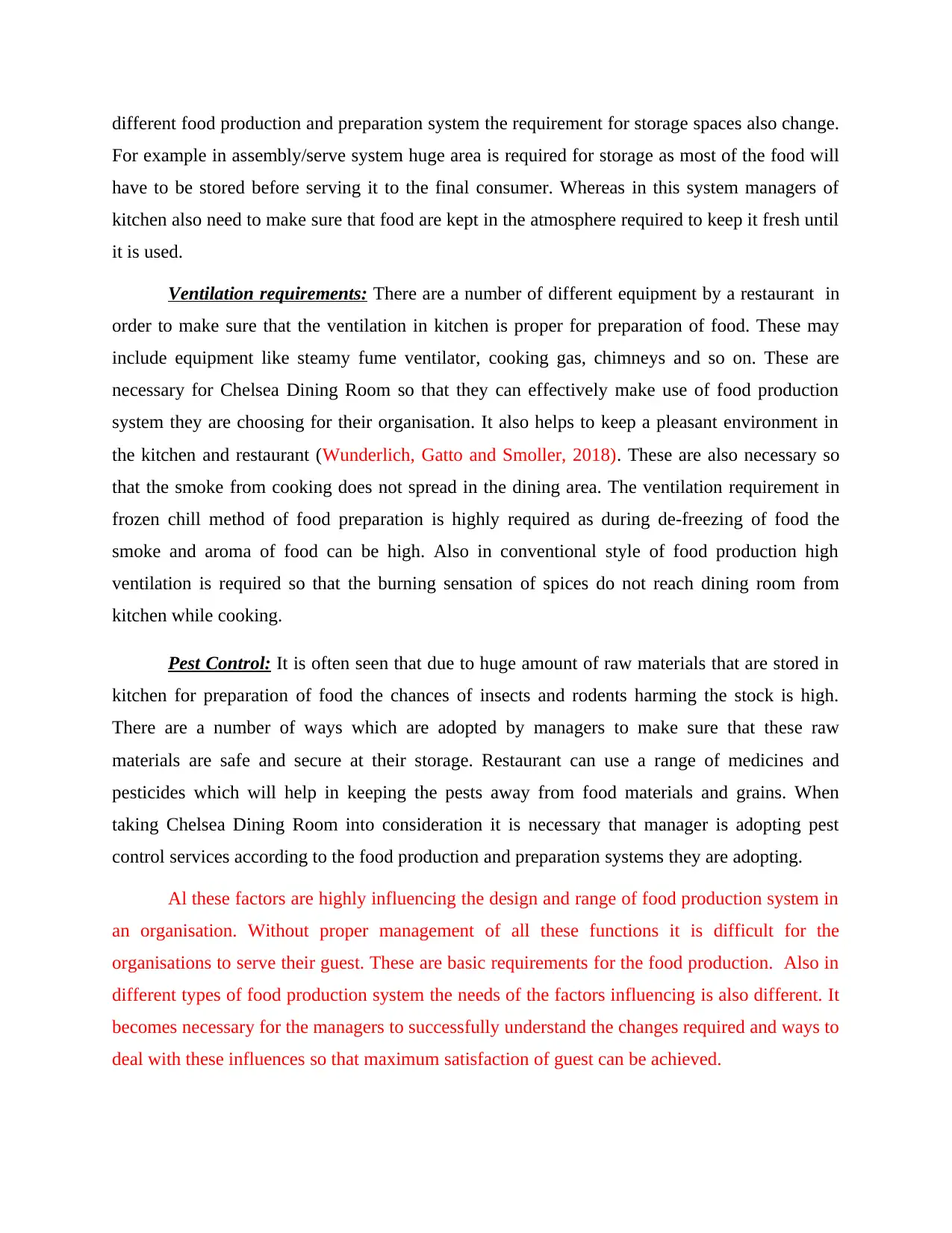
different food production and preparation system the requirement for storage spaces also change.
For example in assembly/serve system huge area is required for storage as most of the food will
have to be stored before serving it to the final consumer. Whereas in this system managers of
kitchen also need to make sure that food are kept in the atmosphere required to keep it fresh until
it is used.
Ventilation requirements: There are a number of different equipment by a restaurant in
order to make sure that the ventilation in kitchen is proper for preparation of food. These may
include equipment like steamy fume ventilator, cooking gas, chimneys and so on. These are
necessary for Chelsea Dining Room so that they can effectively make use of food production
system they are choosing for their organisation. It also helps to keep a pleasant environment in
the kitchen and restaurant (Wunderlich, Gatto and Smoller, 2018). These are also necessary so
that the smoke from cooking does not spread in the dining area. The ventilation requirement in
frozen chill method of food preparation is highly required as during de-freezing of food the
smoke and aroma of food can be high. Also in conventional style of food production high
ventilation is required so that the burning sensation of spices do not reach dining room from
kitchen while cooking.
Pest Control: It is often seen that due to huge amount of raw materials that are stored in
kitchen for preparation of food the chances of insects and rodents harming the stock is high.
There are a number of ways which are adopted by managers to make sure that these raw
materials are safe and secure at their storage. Restaurant can use a range of medicines and
pesticides which will help in keeping the pests away from food materials and grains. When
taking Chelsea Dining Room into consideration it is necessary that manager is adopting pest
control services according to the food production and preparation systems they are adopting.
Al these factors are highly influencing the design and range of food production system in
an organisation. Without proper management of all these functions it is difficult for the
organisations to serve their guest. These are basic requirements for the food production. Also in
different types of food production system the needs of the factors influencing is also different. It
becomes necessary for the managers to successfully understand the changes required and ways to
deal with these influences so that maximum satisfaction of guest can be achieved.
For example in assembly/serve system huge area is required for storage as most of the food will
have to be stored before serving it to the final consumer. Whereas in this system managers of
kitchen also need to make sure that food are kept in the atmosphere required to keep it fresh until
it is used.
Ventilation requirements: There are a number of different equipment by a restaurant in
order to make sure that the ventilation in kitchen is proper for preparation of food. These may
include equipment like steamy fume ventilator, cooking gas, chimneys and so on. These are
necessary for Chelsea Dining Room so that they can effectively make use of food production
system they are choosing for their organisation. It also helps to keep a pleasant environment in
the kitchen and restaurant (Wunderlich, Gatto and Smoller, 2018). These are also necessary so
that the smoke from cooking does not spread in the dining area. The ventilation requirement in
frozen chill method of food preparation is highly required as during de-freezing of food the
smoke and aroma of food can be high. Also in conventional style of food production high
ventilation is required so that the burning sensation of spices do not reach dining room from
kitchen while cooking.
Pest Control: It is often seen that due to huge amount of raw materials that are stored in
kitchen for preparation of food the chances of insects and rodents harming the stock is high.
There are a number of ways which are adopted by managers to make sure that these raw
materials are safe and secure at their storage. Restaurant can use a range of medicines and
pesticides which will help in keeping the pests away from food materials and grains. When
taking Chelsea Dining Room into consideration it is necessary that manager is adopting pest
control services according to the food production and preparation systems they are adopting.
Al these factors are highly influencing the design and range of food production system in
an organisation. Without proper management of all these functions it is difficult for the
organisations to serve their guest. These are basic requirements for the food production. Also in
different types of food production system the needs of the factors influencing is also different. It
becomes necessary for the managers to successfully understand the changes required and ways to
deal with these influences so that maximum satisfaction of guest can be achieved.
Paraphrase This Document
Need a fresh take? Get an instant paraphrase of this document with our AI Paraphraser
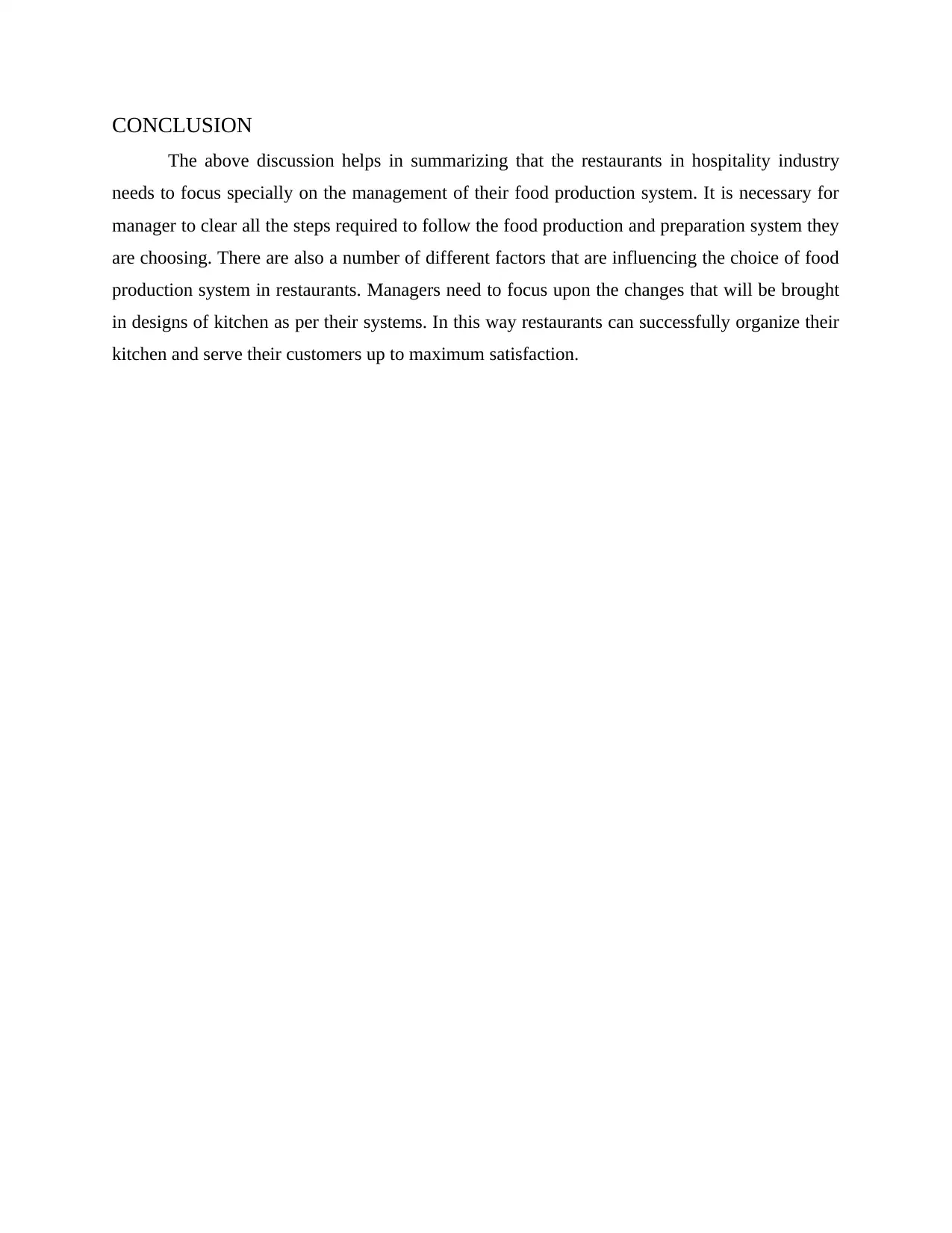
CONCLUSION
The above discussion helps in summarizing that the restaurants in hospitality industry
needs to focus specially on the management of their food production system. It is necessary for
manager to clear all the steps required to follow the food production and preparation system they
are choosing. There are also a number of different factors that are influencing the choice of food
production system in restaurants. Managers need to focus upon the changes that will be brought
in designs of kitchen as per their systems. In this way restaurants can successfully organize their
kitchen and serve their customers up to maximum satisfaction.
The above discussion helps in summarizing that the restaurants in hospitality industry
needs to focus specially on the management of their food production system. It is necessary for
manager to clear all the steps required to follow the food production and preparation system they
are choosing. There are also a number of different factors that are influencing the choice of food
production system in restaurants. Managers need to focus upon the changes that will be brought
in designs of kitchen as per their systems. In this way restaurants can successfully organize their
kitchen and serve their customers up to maximum satisfaction.
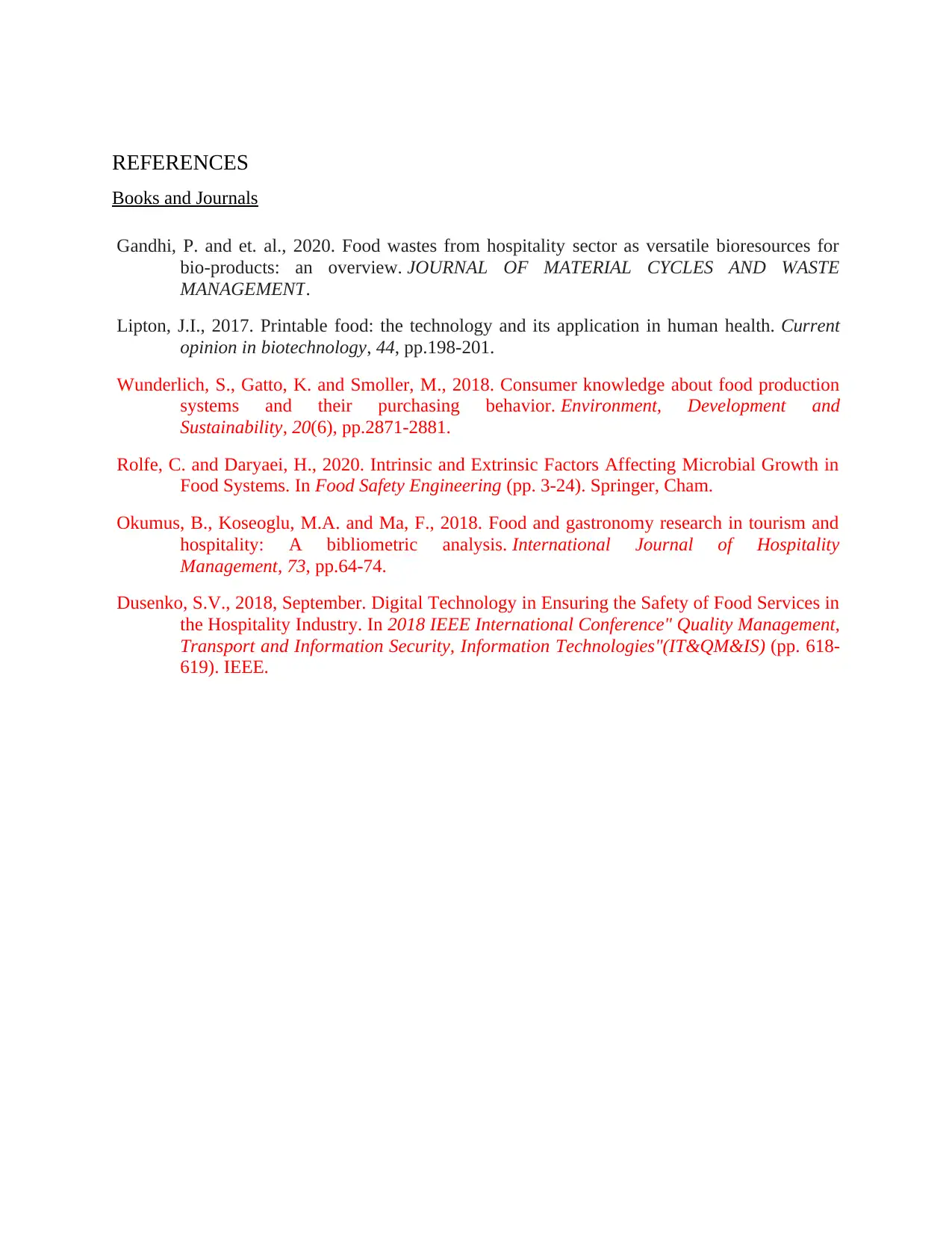
REFERENCES
Books and Journals
Gandhi, P. and et. al., 2020. Food wastes from hospitality sector as versatile bioresources for
bio-products: an overview. JOURNAL OF MATERIAL CYCLES AND WASTE
MANAGEMENT.
Lipton, J.I., 2017. Printable food: the technology and its application in human health. Current
opinion in biotechnology, 44, pp.198-201.
Wunderlich, S., Gatto, K. and Smoller, M., 2018. Consumer knowledge about food production
systems and their purchasing behavior. Environment, Development and
Sustainability, 20(6), pp.2871-2881.
Rolfe, C. and Daryaei, H., 2020. Intrinsic and Extrinsic Factors Affecting Microbial Growth in
Food Systems. In Food Safety Engineering (pp. 3-24). Springer, Cham.
Okumus, B., Koseoglu, M.A. and Ma, F., 2018. Food and gastronomy research in tourism and
hospitality: A bibliometric analysis. International Journal of Hospitality
Management, 73, pp.64-74.
Dusenko, S.V., 2018, September. Digital Technology in Ensuring the Safety of Food Services in
the Hospitality Industry. In 2018 IEEE International Conference" Quality Management,
Transport and Information Security, Information Technologies"(IT&QM&IS) (pp. 618-
619). IEEE.
Books and Journals
Gandhi, P. and et. al., 2020. Food wastes from hospitality sector as versatile bioresources for
bio-products: an overview. JOURNAL OF MATERIAL CYCLES AND WASTE
MANAGEMENT.
Lipton, J.I., 2017. Printable food: the technology and its application in human health. Current
opinion in biotechnology, 44, pp.198-201.
Wunderlich, S., Gatto, K. and Smoller, M., 2018. Consumer knowledge about food production
systems and their purchasing behavior. Environment, Development and
Sustainability, 20(6), pp.2871-2881.
Rolfe, C. and Daryaei, H., 2020. Intrinsic and Extrinsic Factors Affecting Microbial Growth in
Food Systems. In Food Safety Engineering (pp. 3-24). Springer, Cham.
Okumus, B., Koseoglu, M.A. and Ma, F., 2018. Food and gastronomy research in tourism and
hospitality: A bibliometric analysis. International Journal of Hospitality
Management, 73, pp.64-74.
Dusenko, S.V., 2018, September. Digital Technology in Ensuring the Safety of Food Services in
the Hospitality Industry. In 2018 IEEE International Conference" Quality Management,
Transport and Information Security, Information Technologies"(IT&QM&IS) (pp. 618-
619). IEEE.
⊘ This is a preview!⊘
Do you want full access?
Subscribe today to unlock all pages.

Trusted by 1+ million students worldwide
1 out of 9
Related Documents
Your All-in-One AI-Powered Toolkit for Academic Success.
+13062052269
info@desklib.com
Available 24*7 on WhatsApp / Email
![[object Object]](/_next/static/media/star-bottom.7253800d.svg)
Unlock your academic potential
Copyright © 2020–2025 A2Z Services. All Rights Reserved. Developed and managed by ZUCOL.





